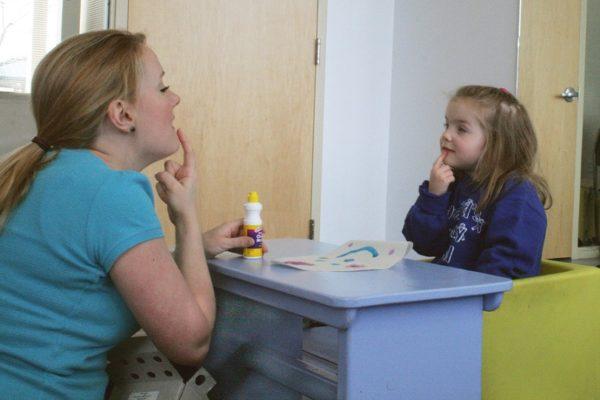Is My Child Stuttering? Understanding Speech Issues in Young Children
Does it ever feel like your child is having trouble getting a sentence out, or repeating sounds within certain words?

Or do you notice that it seems like they can’t get a word out at all? You may observe this in your little one and wonder: is my child stuttering? Don’t worry! There are certain exercises to help a stuttering child overcome their speech disfluency.
Stuttering is a type of speech disfluency that some children develop as they begin to talk. The most common type of stuttering in children is developmental stuttering, which may impact them between the ages of 2.5 and 5. In this type of stuttering, children have a hard time expressing what they want to say.
For many children, this will go away with time, and is a sign that their language is getting more complex. As children try to produce longer and more complex sentences, their motor pathways in their brain may have trouble keeping up with the demand, and stuttering can occur. But if a child is displaying signs of stuttering, it’s important to pay attention and bring this to a healthcare provider’s attention, so they can intervene early if needed.
When looking particularly at stuttering, there are some common behaviors that children may display during speech:
Repeating. This can be repeating sounds and/or syllables (such as “B-b-b-baby”), words (“Go-go-go away”) or phrases (“She said—she said I could.”)
Prolonging syllables, words or phrases. This may sound like: “Sssssounds good.”
Blocking. This is when no sound is made during certain syllables or words. An example may be a child saying: “I want to (pause) go swimming.”
Here are some signs to look for in your child’s speech to see if they are displaying signs of a more typical disfluencies (which children may grow out of):
Repeating whole phrases or words rather than syllables. For example, they may repeat: “I would like—I would like some ice cream” or “Go—go away.”
Using filler words, such as “um” or “uh.”
They do not experience any physical struggles or tension while speaking. They don’t display any frustration when speaking or any other unusual behaviors like blinking, throat clearing or hand tapping.
On the other hand, here are some signs of atypical disfluencies, which may support earlier intervention from a speech-language pathologist. If your child is displaying any of these signs, it’s recommended you speak to a healthcare provider:
Repeating sounds or syllables. This may sound like, “I want to g-g-g-go.”
Prolonging sounds. This may sound like, “Sssssssometimes I go to the park.”
Experiencing blocks. You may notice your child pauses while speaking or may even appear to physically struggle when trying to get a word out.
Frustration during speaking.
Other physical behaviors, like blinking, tapping or clearing their throat.
Additionally, consider these factors if you aren’t sure if you should speak to a healthcare provider:
It’s common for children to experience disfluencies in the age range of 2.5 to 5 years old. However, if a child starts experiencing issues later in this range (such as at 4 years old), or is still experiencing issues around age 5, it’s best to talk to a healthcare provider.
Length of issue. If your child has been dealing with disfluencies for longer than 6 months, it is best to talk to a healthcare provider.
Young boys are much more likely to have a speech issue than young girls (3-4 times more likely, in fact).
Family history. Does your family have a history of speech issues, such as stuttering? There is a genetic connection, so if you’re concerned about a genetic risk, speak to a healthcare provider.
No matter what your child is experiencing, it is always important to follow your instincts and ask a healthcare provider if you’d like to know more.
How is stuttering treated? This all depends on the age of the child, how long the issue has been present, and many other factors. This is true in all areas of development, but it’s important to emphasize it here: When treated early, stuttering is much more likely to be significantly reduced or possibly eliminated.
 If a healthcare provider thinks your child may be stuttering, they will likely refer you to a speech-language pathologist to help support their speech development. They may receive indirect or direct treatment, or a combination of both. Indirect treatment (which is most effective for younger children) involves ways for parents to change their speech, including decreasing speech demands placed on a child, which will positively impact their child. For example, they may prescribe certain exercises to help the stuttering child. Direct treatment is one-on-one treatment between a speech language pathologist and a child to help reduce stuttering. This also includes parent education and strategies to use in all environments.
If a healthcare provider thinks your child may be stuttering, they will likely refer you to a speech-language pathologist to help support their speech development. They may receive indirect or direct treatment, or a combination of both. Indirect treatment (which is most effective for younger children) involves ways for parents to change their speech, including decreasing speech demands placed on a child, which will positively impact their child. For example, they may prescribe certain exercises to help the stuttering child. Direct treatment is one-on-one treatment between a speech language pathologist and a child to help reduce stuttering. This also includes parent education and strategies to use in all environments.
Remember, with stuttering and any speech issues, the earlier the better! So if you suspect an issue or your little one is not meeting their communication milestones, talk to a healthcare provider.





